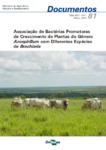Please use this identifier to cite or link to this item:
http://www.infoteca.cnptia.embrapa.br/infoteca/handle/doc/567997Full metadata record
| DC Field | Value | Language |
|---|---|---|
| dc.contributor.author | REIS JÚNIOR, F. B. dos | pt_BR |
| dc.contributor.author | TEIXEIRA, K. R. dos S. | pt_BR |
| dc.contributor.author | URQUIAGA, S. | pt_BR |
| dc.contributor.author | REIS, V. M. | pt_BR |
| dc.date.accessioned | 2011-07-08T11:44:22Z | - |
| dc.date.available | 2011-07-08T11:44:22Z | - |
| dc.date.created | 2004-12-10 | pt_BR |
| dc.date.issued | 2003 | pt_BR |
| dc.identifier.citation | Planaltina, DF: Embrapa Cerrados, 2003. | pt_BR |
| dc.identifier.uri | http://www.infoteca.cnptia.embrapa.br/infoteca/handle/doc/567997 | pt_BR |
| dc.description | ABSTRACT: The limitation of nitrogen is considered one of the most important factors to the pastures degradation. However there are evidences that pastures formed by some species of the genus Brachiaria could be benefit with the biological nitrogen fixation process (BNF), guaranteeing to these pastures higher longevity. The diazotrophic bacteria founded in association with these forage grasses were mainly species from the Azospirillum genus. The associations between these microrganisms and the plants are generally conditioned to the vegetation, therefore is possible that different genotypes of Brachiaria exercise a selective efffect on the populations of these, what could result in different BNF contributions. It was objectified to establish the influence of the Brachiaria species, pasture management and seasonal variations on the bacteria populations from the Azospirillum genus associated with the roots of these plants. Different pastures (B.humidicola, B. decumbens and B. brizantha) were implanted in areas of the Cerrado ecosystem and of the Atlantic Forest. Two management systems with different stocking rates (higher and lower) were evaluated. The collects of plant samples from each experimental treatment were accomplished in different times of the year. For the isolation and qualification of the diazotrophic bacteria traditional techniques were utilised with the use of semi-specific and semi-solid culture media without nitrogen. A. lipoferum, A. brasiliense and A. amazonense were isolated from root samples of the three analysed Brachiaria species. The estimates of the bacterial populations from these species varied from 10(elevado a 3) - 10 (elevado a 7) cells. g. of roots. In the samples of the Cerrado ecosystem, the collect time presented significant effects on the population of these bacteria. The data from the Atlantic forest region experiment showed that plants of Brachiaria from different species and pastures under different stocking rates can present different populations numbers of Azospirillum spp. associated to its roots. | pt_BR |
| dc.language.iso | por | pt_BR |
| dc.relation.ispartofseries | (Embrapa Cerrados. Documentos, 81). | pt_BR |
| dc.rights | openAccess | pt_BR |
| dc.subject | Degredação | pt_BR |
| dc.title | Associação de bactérias promotoras de crescimento de plantas do gênero Azospirillum com diferentes espécies de brachiaria. | pt_BR |
| dc.type | Livros | pt_BR |
| dc.date.updated | 2011-07-08T11:44:22Z | pt_BR |
| dc.subject.thesagro | Bactéria | pt_BR |
| dc.subject.thesagro | Brachiaria | pt_BR |
| dc.subject.thesagro | Fixação de Nitrogênio | pt_BR |
| dc.subject.thesagro | Microbiologia do Solo | pt_BR |
| dc.subject.thesagro | Pastagem | pt_BR |
| dc.subject.nalthesaurus | Azospirillum amazonense | pt_BR |
| dc.subject.nalthesaurus | degradation | pt_BR |
| dc.subject.nalthesaurus | pastures | pt_BR |
| dc.subject.nalthesaurus | microbiology | pt_BR |
| dc.subject.nalthesaurus | nitrogen fixation | pt_BR |
| dc.subject.nalthesaurus | soil | pt_BR |
| dc.format.extent2 | 52 p. | pt_BR |
| riaa.ainfo.id | 567997 | pt_BR |
| riaa.ainfo.lastupdate | 2009-10-28 | pt_BR |
| Appears in Collections: | Série Documentos (CPAC)  | |










